HI5019 Strategic Information Systems: Tutorial Questions Week 6-10
VerifiedAdded on 2023/01/10
|8
|2025
|96
Homework Assignment
AI Summary
This document provides answers to tutorial questions related to Strategic Information Systems, covering topics such as conversion cycles, internal control weaknesses, REA models, auditor independence, and systems development methodologies. It discusses risks in production systems, accounting irregularities, and the importance of data integrity in auditing. Furthermore, it explores the benefits of a fresh systems development approach using the SDLC and object-oriented methods, emphasizing the need for comprehensive analysis and stakeholder involvement. Desklib offers a wealth of similar solved assignments and study resources to aid students in their academic pursuits.
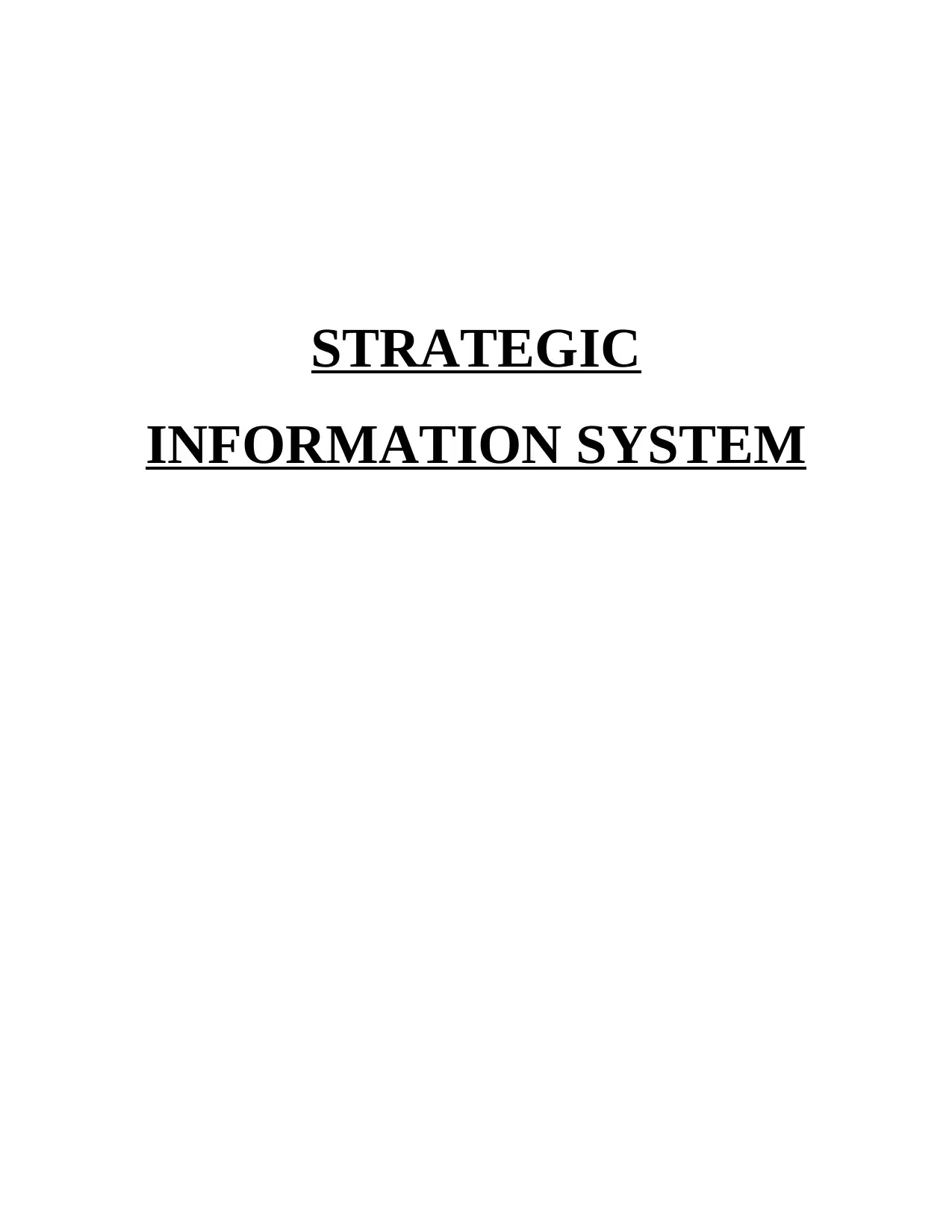
STRATEGIC
INFORMATION SYSTEM
INFORMATION SYSTEM
Paraphrase This Document
Need a fresh take? Get an instant paraphrase of this document with our AI Paraphraser
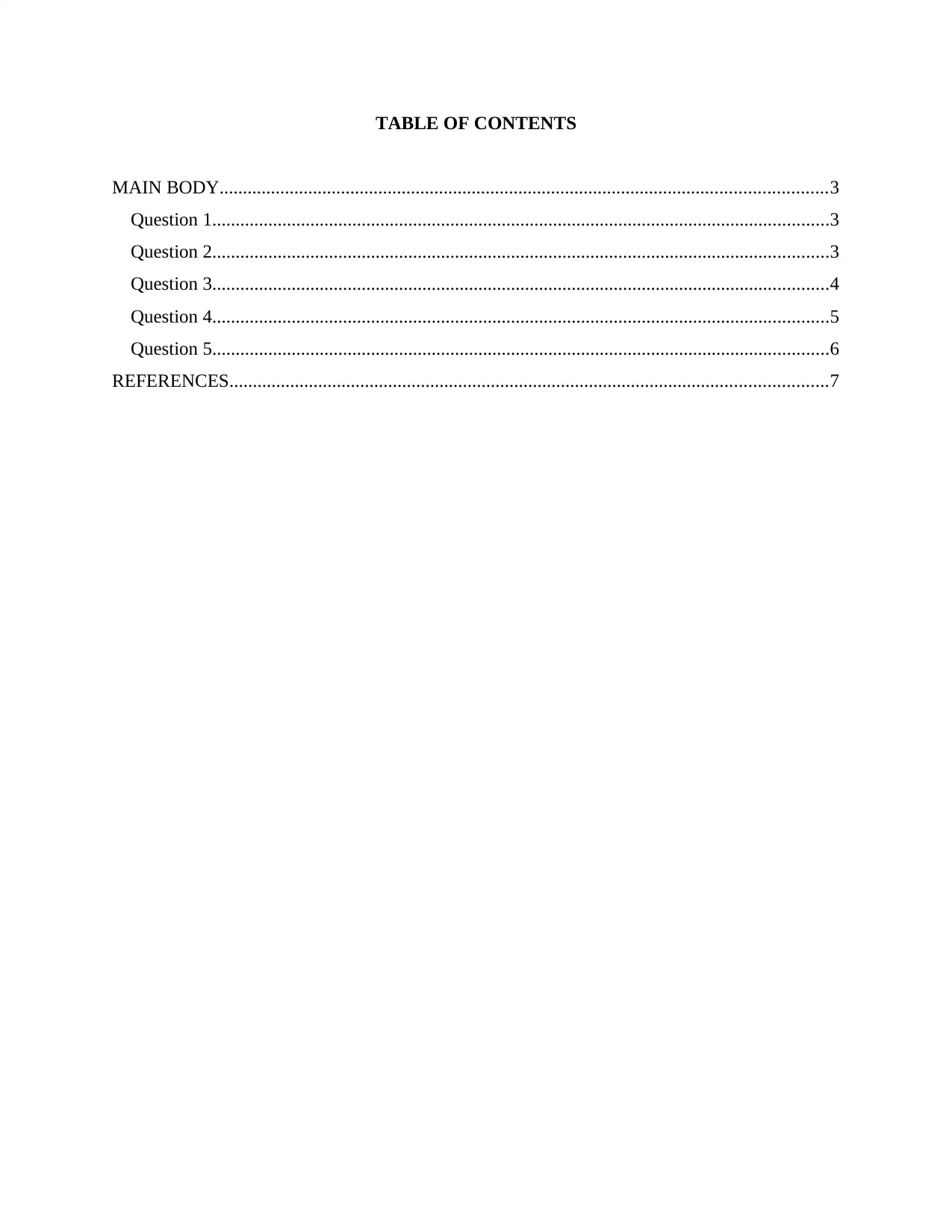
TABLE OF CONTENTS
MAIN BODY..................................................................................................................................3
Question 1....................................................................................................................................3
Question 2....................................................................................................................................3
Question 3....................................................................................................................................4
Question 4....................................................................................................................................5
Question 5....................................................................................................................................6
REFERENCES................................................................................................................................7
MAIN BODY..................................................................................................................................3
Question 1....................................................................................................................................3
Question 2....................................................................................................................................3
Question 3....................................................................................................................................4
Question 4....................................................................................................................................5
Question 5....................................................................................................................................6
REFERENCES................................................................................................................................7
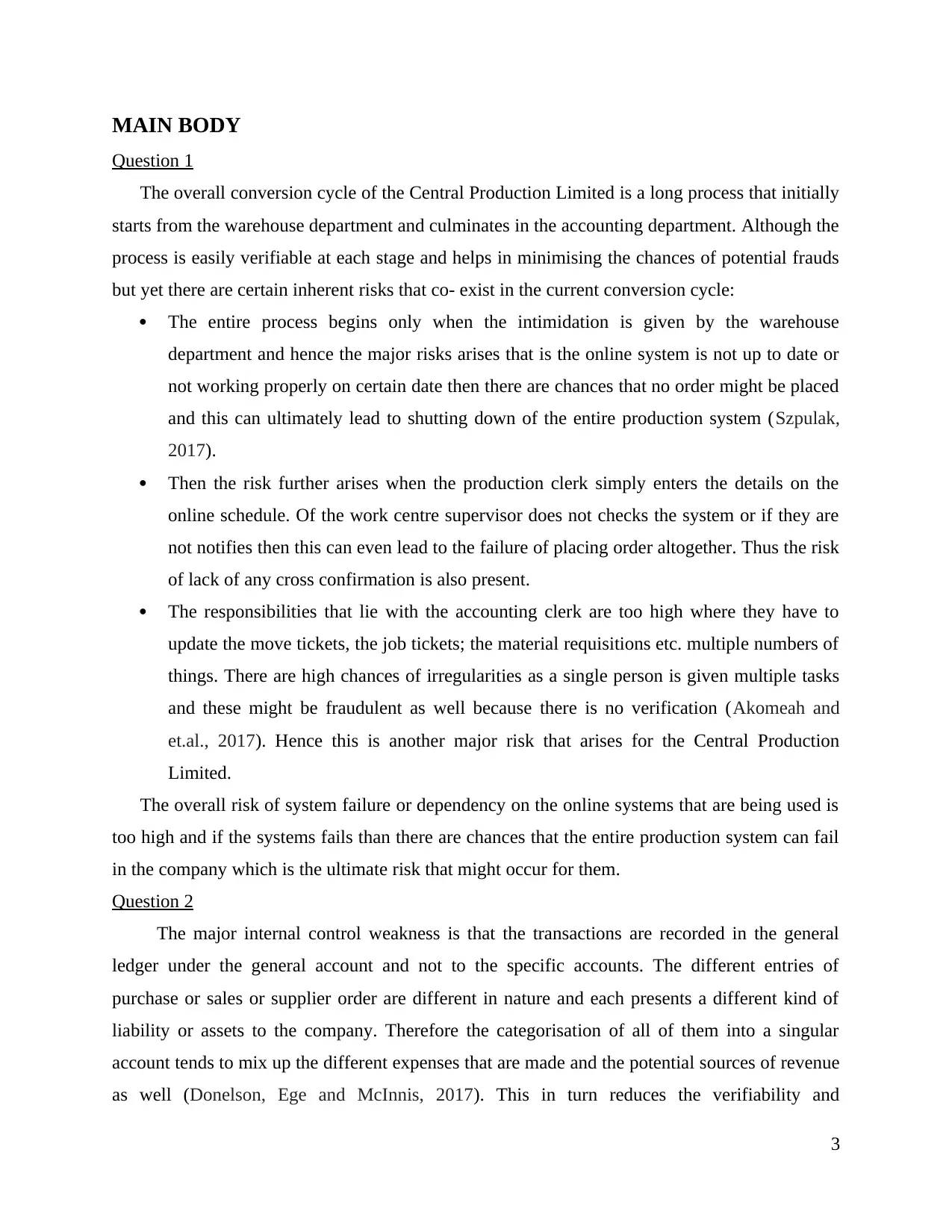
MAIN BODY
Question 1
The overall conversion cycle of the Central Production Limited is a long process that initially
starts from the warehouse department and culminates in the accounting department. Although the
process is easily verifiable at each stage and helps in minimising the chances of potential frauds
but yet there are certain inherent risks that co- exist in the current conversion cycle:
The entire process begins only when the intimidation is given by the warehouse
department and hence the major risks arises that is the online system is not up to date or
not working properly on certain date then there are chances that no order might be placed
and this can ultimately lead to shutting down of the entire production system (Szpulak,
2017).
Then the risk further arises when the production clerk simply enters the details on the
online schedule. Of the work centre supervisor does not checks the system or if they are
not notifies then this can even lead to the failure of placing order altogether. Thus the risk
of lack of any cross confirmation is also present.
The responsibilities that lie with the accounting clerk are too high where they have to
update the move tickets, the job tickets; the material requisitions etc. multiple numbers of
things. There are high chances of irregularities as a single person is given multiple tasks
and these might be fraudulent as well because there is no verification (Akomeah and
et.al., 2017). Hence this is another major risk that arises for the Central Production
Limited.
The overall risk of system failure or dependency on the online systems that are being used is
too high and if the systems fails than there are chances that the entire production system can fail
in the company which is the ultimate risk that might occur for them.
Question 2
The major internal control weakness is that the transactions are recorded in the general
ledger under the general account and not to the specific accounts. The different entries of
purchase or sales or supplier order are different in nature and each presents a different kind of
liability or assets to the company. Therefore the categorisation of all of them into a singular
account tends to mix up the different expenses that are made and the potential sources of revenue
as well (Donelson, Ege and McInnis, 2017). This in turn reduces the verifiability and
3
Question 1
The overall conversion cycle of the Central Production Limited is a long process that initially
starts from the warehouse department and culminates in the accounting department. Although the
process is easily verifiable at each stage and helps in minimising the chances of potential frauds
but yet there are certain inherent risks that co- exist in the current conversion cycle:
The entire process begins only when the intimidation is given by the warehouse
department and hence the major risks arises that is the online system is not up to date or
not working properly on certain date then there are chances that no order might be placed
and this can ultimately lead to shutting down of the entire production system (Szpulak,
2017).
Then the risk further arises when the production clerk simply enters the details on the
online schedule. Of the work centre supervisor does not checks the system or if they are
not notifies then this can even lead to the failure of placing order altogether. Thus the risk
of lack of any cross confirmation is also present.
The responsibilities that lie with the accounting clerk are too high where they have to
update the move tickets, the job tickets; the material requisitions etc. multiple numbers of
things. There are high chances of irregularities as a single person is given multiple tasks
and these might be fraudulent as well because there is no verification (Akomeah and
et.al., 2017). Hence this is another major risk that arises for the Central Production
Limited.
The overall risk of system failure or dependency on the online systems that are being used is
too high and if the systems fails than there are chances that the entire production system can fail
in the company which is the ultimate risk that might occur for them.
Question 2
The major internal control weakness is that the transactions are recorded in the general
ledger under the general account and not to the specific accounts. The different entries of
purchase or sales or supplier order are different in nature and each presents a different kind of
liability or assets to the company. Therefore the categorisation of all of them into a singular
account tends to mix up the different expenses that are made and the potential sources of revenue
as well (Donelson, Ege and McInnis, 2017). This in turn reduces the verifiability and
3
⊘ This is a preview!⊘
Do you want full access?
Subscribe today to unlock all pages.

Trusted by 1+ million students worldwide
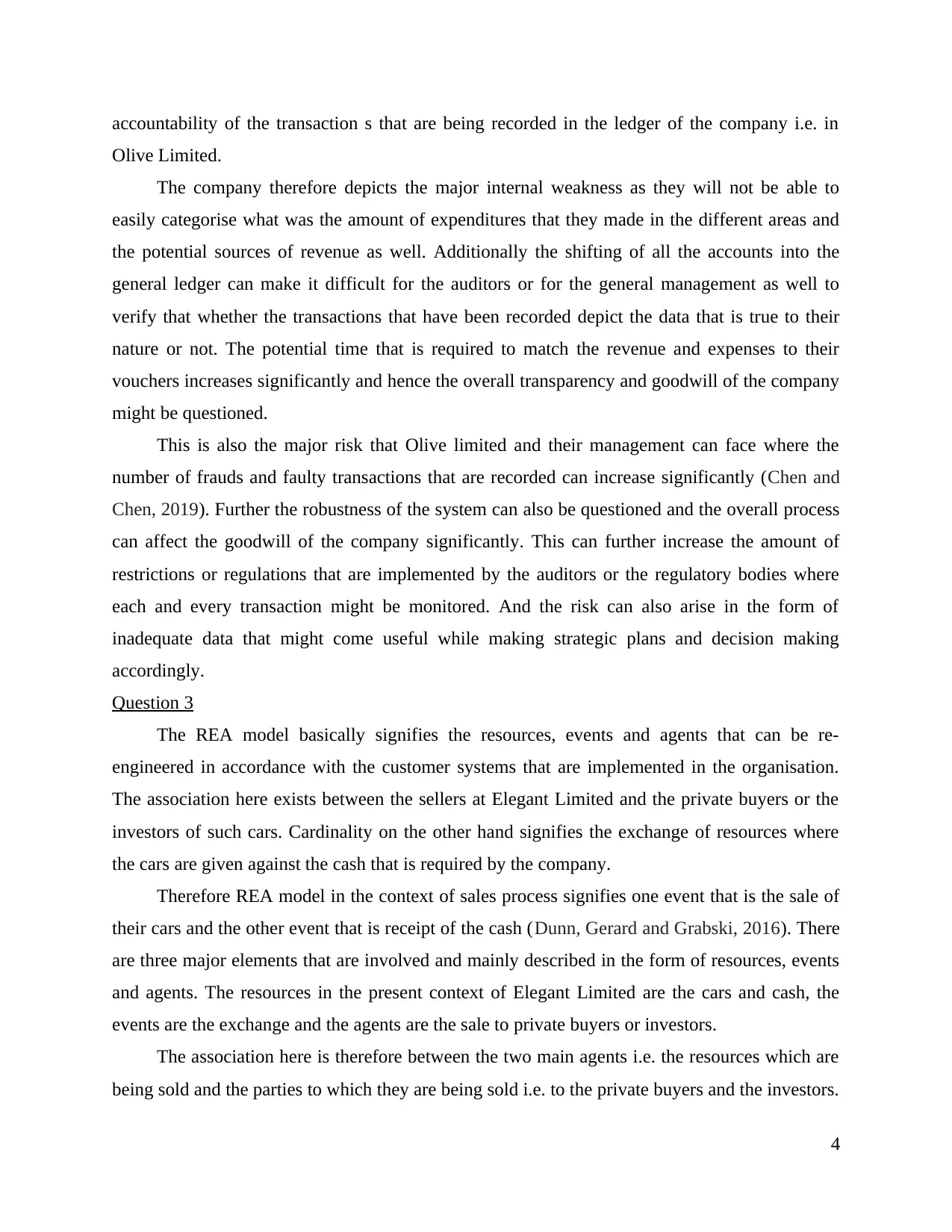
accountability of the transaction s that are being recorded in the ledger of the company i.e. in
Olive Limited.
The company therefore depicts the major internal weakness as they will not be able to
easily categorise what was the amount of expenditures that they made in the different areas and
the potential sources of revenue as well. Additionally the shifting of all the accounts into the
general ledger can make it difficult for the auditors or for the general management as well to
verify that whether the transactions that have been recorded depict the data that is true to their
nature or not. The potential time that is required to match the revenue and expenses to their
vouchers increases significantly and hence the overall transparency and goodwill of the company
might be questioned.
This is also the major risk that Olive limited and their management can face where the
number of frauds and faulty transactions that are recorded can increase significantly (Chen and
Chen, 2019). Further the robustness of the system can also be questioned and the overall process
can affect the goodwill of the company significantly. This can further increase the amount of
restrictions or regulations that are implemented by the auditors or the regulatory bodies where
each and every transaction might be monitored. And the risk can also arise in the form of
inadequate data that might come useful while making strategic plans and decision making
accordingly.
Question 3
The REA model basically signifies the resources, events and agents that can be re-
engineered in accordance with the customer systems that are implemented in the organisation.
The association here exists between the sellers at Elegant Limited and the private buyers or the
investors of such cars. Cardinality on the other hand signifies the exchange of resources where
the cars are given against the cash that is required by the company.
Therefore REA model in the context of sales process signifies one event that is the sale of
their cars and the other event that is receipt of the cash (Dunn, Gerard and Grabski, 2016). There
are three major elements that are involved and mainly described in the form of resources, events
and agents. The resources in the present context of Elegant Limited are the cars and cash, the
events are the exchange and the agents are the sale to private buyers or investors.
The association here is therefore between the two main agents i.e. the resources which are
being sold and the parties to which they are being sold i.e. to the private buyers and the investors.
4
Olive Limited.
The company therefore depicts the major internal weakness as they will not be able to
easily categorise what was the amount of expenditures that they made in the different areas and
the potential sources of revenue as well. Additionally the shifting of all the accounts into the
general ledger can make it difficult for the auditors or for the general management as well to
verify that whether the transactions that have been recorded depict the data that is true to their
nature or not. The potential time that is required to match the revenue and expenses to their
vouchers increases significantly and hence the overall transparency and goodwill of the company
might be questioned.
This is also the major risk that Olive limited and their management can face where the
number of frauds and faulty transactions that are recorded can increase significantly (Chen and
Chen, 2019). Further the robustness of the system can also be questioned and the overall process
can affect the goodwill of the company significantly. This can further increase the amount of
restrictions or regulations that are implemented by the auditors or the regulatory bodies where
each and every transaction might be monitored. And the risk can also arise in the form of
inadequate data that might come useful while making strategic plans and decision making
accordingly.
Question 3
The REA model basically signifies the resources, events and agents that can be re-
engineered in accordance with the customer systems that are implemented in the organisation.
The association here exists between the sellers at Elegant Limited and the private buyers or the
investors of such cars. Cardinality on the other hand signifies the exchange of resources where
the cars are given against the cash that is required by the company.
Therefore REA model in the context of sales process signifies one event that is the sale of
their cars and the other event that is receipt of the cash (Dunn, Gerard and Grabski, 2016). There
are three major elements that are involved and mainly described in the form of resources, events
and agents. The resources in the present context of Elegant Limited are the cars and cash, the
events are the exchange and the agents are the sale to private buyers or investors.
The association here is therefore between the two main agents i.e. the resources which are
being sold and the parties to which they are being sold i.e. to the private buyers and the investors.
4
Paraphrase This Document
Need a fresh take? Get an instant paraphrase of this document with our AI Paraphraser
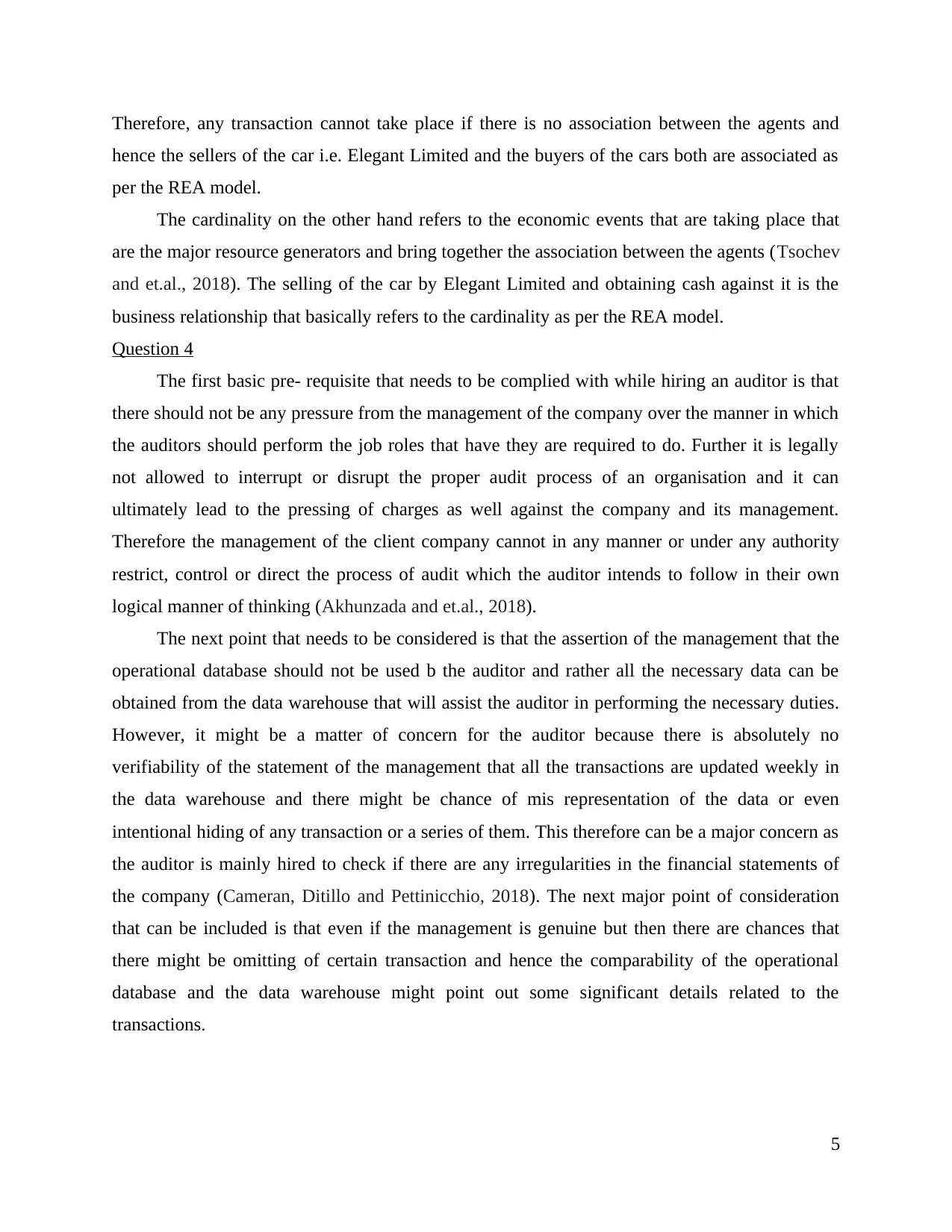
Therefore, any transaction cannot take place if there is no association between the agents and
hence the sellers of the car i.e. Elegant Limited and the buyers of the cars both are associated as
per the REA model.
The cardinality on the other hand refers to the economic events that are taking place that
are the major resource generators and bring together the association between the agents (Tsochev
and et.al., 2018). The selling of the car by Elegant Limited and obtaining cash against it is the
business relationship that basically refers to the cardinality as per the REA model.
Question 4
The first basic pre- requisite that needs to be complied with while hiring an auditor is that
there should not be any pressure from the management of the company over the manner in which
the auditors should perform the job roles that have they are required to do. Further it is legally
not allowed to interrupt or disrupt the proper audit process of an organisation and it can
ultimately lead to the pressing of charges as well against the company and its management.
Therefore the management of the client company cannot in any manner or under any authority
restrict, control or direct the process of audit which the auditor intends to follow in their own
logical manner of thinking (Akhunzada and et.al., 2018).
The next point that needs to be considered is that the assertion of the management that the
operational database should not be used b the auditor and rather all the necessary data can be
obtained from the data warehouse that will assist the auditor in performing the necessary duties.
However, it might be a matter of concern for the auditor because there is absolutely no
verifiability of the statement of the management that all the transactions are updated weekly in
the data warehouse and there might be chance of mis representation of the data or even
intentional hiding of any transaction or a series of them. This therefore can be a major concern as
the auditor is mainly hired to check if there are any irregularities in the financial statements of
the company (Cameran, Ditillo and Pettinicchio, 2018). The next major point of consideration
that can be included is that even if the management is genuine but then there are chances that
there might be omitting of certain transaction and hence the comparability of the operational
database and the data warehouse might point out some significant details related to the
transactions.
5
hence the sellers of the car i.e. Elegant Limited and the buyers of the cars both are associated as
per the REA model.
The cardinality on the other hand refers to the economic events that are taking place that
are the major resource generators and bring together the association between the agents (Tsochev
and et.al., 2018). The selling of the car by Elegant Limited and obtaining cash against it is the
business relationship that basically refers to the cardinality as per the REA model.
Question 4
The first basic pre- requisite that needs to be complied with while hiring an auditor is that
there should not be any pressure from the management of the company over the manner in which
the auditors should perform the job roles that have they are required to do. Further it is legally
not allowed to interrupt or disrupt the proper audit process of an organisation and it can
ultimately lead to the pressing of charges as well against the company and its management.
Therefore the management of the client company cannot in any manner or under any authority
restrict, control or direct the process of audit which the auditor intends to follow in their own
logical manner of thinking (Akhunzada and et.al., 2018).
The next point that needs to be considered is that the assertion of the management that the
operational database should not be used b the auditor and rather all the necessary data can be
obtained from the data warehouse that will assist the auditor in performing the necessary duties.
However, it might be a matter of concern for the auditor because there is absolutely no
verifiability of the statement of the management that all the transactions are updated weekly in
the data warehouse and there might be chance of mis representation of the data or even
intentional hiding of any transaction or a series of them. This therefore can be a major concern as
the auditor is mainly hired to check if there are any irregularities in the financial statements of
the company (Cameran, Ditillo and Pettinicchio, 2018). The next major point of consideration
that can be included is that even if the management is genuine but then there are chances that
there might be omitting of certain transaction and hence the comparability of the operational
database and the data warehouse might point out some significant details related to the
transactions.
5
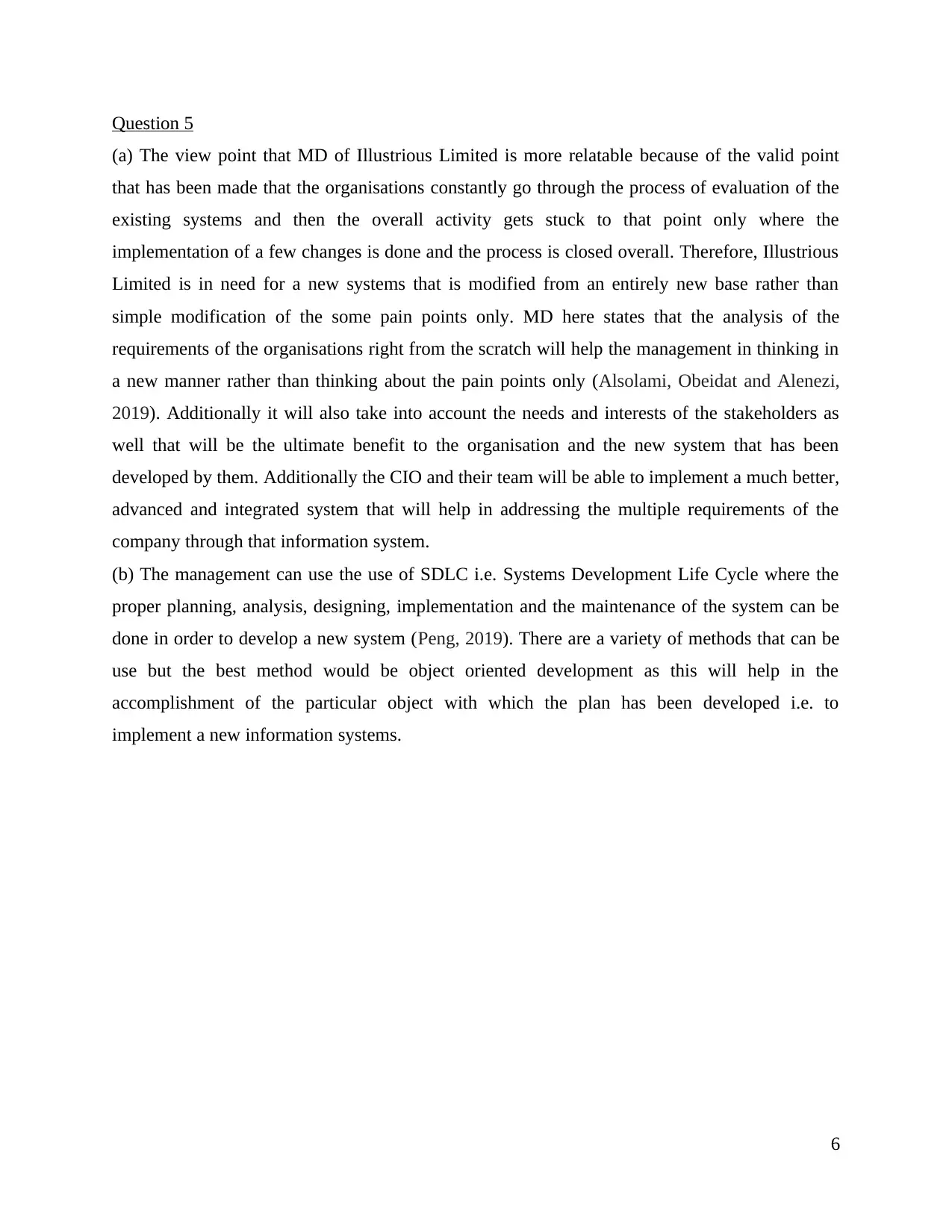
Question 5
(a) The view point that MD of Illustrious Limited is more relatable because of the valid point
that has been made that the organisations constantly go through the process of evaluation of the
existing systems and then the overall activity gets stuck to that point only where the
implementation of a few changes is done and the process is closed overall. Therefore, Illustrious
Limited is in need for a new systems that is modified from an entirely new base rather than
simple modification of the some pain points only. MD here states that the analysis of the
requirements of the organisations right from the scratch will help the management in thinking in
a new manner rather than thinking about the pain points only (Alsolami, Obeidat and Alenezi,
2019). Additionally it will also take into account the needs and interests of the stakeholders as
well that will be the ultimate benefit to the organisation and the new system that has been
developed by them. Additionally the CIO and their team will be able to implement a much better,
advanced and integrated system that will help in addressing the multiple requirements of the
company through that information system.
(b) The management can use the use of SDLC i.e. Systems Development Life Cycle where the
proper planning, analysis, designing, implementation and the maintenance of the system can be
done in order to develop a new system (Peng, 2019). There are a variety of methods that can be
use but the best method would be object oriented development as this will help in the
accomplishment of the particular object with which the plan has been developed i.e. to
implement a new information systems.
6
(a) The view point that MD of Illustrious Limited is more relatable because of the valid point
that has been made that the organisations constantly go through the process of evaluation of the
existing systems and then the overall activity gets stuck to that point only where the
implementation of a few changes is done and the process is closed overall. Therefore, Illustrious
Limited is in need for a new systems that is modified from an entirely new base rather than
simple modification of the some pain points only. MD here states that the analysis of the
requirements of the organisations right from the scratch will help the management in thinking in
a new manner rather than thinking about the pain points only (Alsolami, Obeidat and Alenezi,
2019). Additionally it will also take into account the needs and interests of the stakeholders as
well that will be the ultimate benefit to the organisation and the new system that has been
developed by them. Additionally the CIO and their team will be able to implement a much better,
advanced and integrated system that will help in addressing the multiple requirements of the
company through that information system.
(b) The management can use the use of SDLC i.e. Systems Development Life Cycle where the
proper planning, analysis, designing, implementation and the maintenance of the system can be
done in order to develop a new system (Peng, 2019). There are a variety of methods that can be
use but the best method would be object oriented development as this will help in the
accomplishment of the particular object with which the plan has been developed i.e. to
implement a new information systems.
6
⊘ This is a preview!⊘
Do you want full access?
Subscribe today to unlock all pages.

Trusted by 1+ million students worldwide
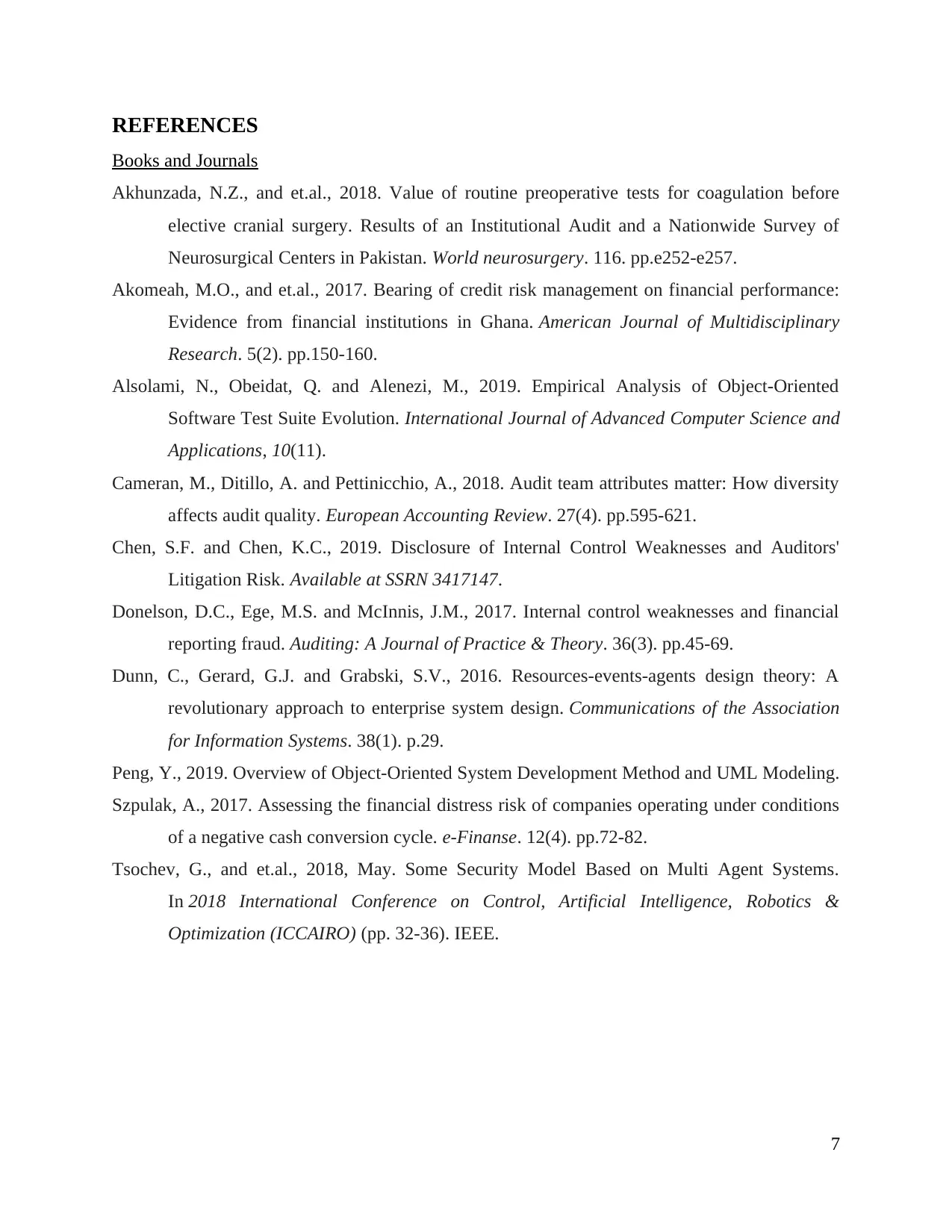
REFERENCES
Books and Journals
Akhunzada, N.Z., and et.al., 2018. Value of routine preoperative tests for coagulation before
elective cranial surgery. Results of an Institutional Audit and a Nationwide Survey of
Neurosurgical Centers in Pakistan. World neurosurgery. 116. pp.e252-e257.
Akomeah, M.O., and et.al., 2017. Bearing of credit risk management on financial performance:
Evidence from financial institutions in Ghana. American Journal of Multidisciplinary
Research. 5(2). pp.150-160.
Alsolami, N., Obeidat, Q. and Alenezi, M., 2019. Empirical Analysis of Object-Oriented
Software Test Suite Evolution. International Journal of Advanced Computer Science and
Applications, 10(11).
Cameran, M., Ditillo, A. and Pettinicchio, A., 2018. Audit team attributes matter: How diversity
affects audit quality. European Accounting Review. 27(4). pp.595-621.
Chen, S.F. and Chen, K.C., 2019. Disclosure of Internal Control Weaknesses and Auditors'
Litigation Risk. Available at SSRN 3417147.
Donelson, D.C., Ege, M.S. and McInnis, J.M., 2017. Internal control weaknesses and financial
reporting fraud. Auditing: A Journal of Practice & Theory. 36(3). pp.45-69.
Dunn, C., Gerard, G.J. and Grabski, S.V., 2016. Resources-events-agents design theory: A
revolutionary approach to enterprise system design. Communications of the Association
for Information Systems. 38(1). p.29.
Peng, Y., 2019. Overview of Object-Oriented System Development Method and UML Modeling.
Szpulak, A., 2017. Assessing the financial distress risk of companies operating under conditions
of a negative cash conversion cycle. e-Finanse. 12(4). pp.72-82.
Tsochev, G., and et.al., 2018, May. Some Security Model Based on Multi Agent Systems.
In 2018 International Conference on Control, Artificial Intelligence, Robotics &
Optimization (ICCAIRO) (pp. 32-36). IEEE.
7
Books and Journals
Akhunzada, N.Z., and et.al., 2018. Value of routine preoperative tests for coagulation before
elective cranial surgery. Results of an Institutional Audit and a Nationwide Survey of
Neurosurgical Centers in Pakistan. World neurosurgery. 116. pp.e252-e257.
Akomeah, M.O., and et.al., 2017. Bearing of credit risk management on financial performance:
Evidence from financial institutions in Ghana. American Journal of Multidisciplinary
Research. 5(2). pp.150-160.
Alsolami, N., Obeidat, Q. and Alenezi, M., 2019. Empirical Analysis of Object-Oriented
Software Test Suite Evolution. International Journal of Advanced Computer Science and
Applications, 10(11).
Cameran, M., Ditillo, A. and Pettinicchio, A., 2018. Audit team attributes matter: How diversity
affects audit quality. European Accounting Review. 27(4). pp.595-621.
Chen, S.F. and Chen, K.C., 2019. Disclosure of Internal Control Weaknesses and Auditors'
Litigation Risk. Available at SSRN 3417147.
Donelson, D.C., Ege, M.S. and McInnis, J.M., 2017. Internal control weaknesses and financial
reporting fraud. Auditing: A Journal of Practice & Theory. 36(3). pp.45-69.
Dunn, C., Gerard, G.J. and Grabski, S.V., 2016. Resources-events-agents design theory: A
revolutionary approach to enterprise system design. Communications of the Association
for Information Systems. 38(1). p.29.
Peng, Y., 2019. Overview of Object-Oriented System Development Method and UML Modeling.
Szpulak, A., 2017. Assessing the financial distress risk of companies operating under conditions
of a negative cash conversion cycle. e-Finanse. 12(4). pp.72-82.
Tsochev, G., and et.al., 2018, May. Some Security Model Based on Multi Agent Systems.
In 2018 International Conference on Control, Artificial Intelligence, Robotics &
Optimization (ICCAIRO) (pp. 32-36). IEEE.
7
Paraphrase This Document
Need a fresh take? Get an instant paraphrase of this document with our AI Paraphraser

8
1 out of 8
Your All-in-One AI-Powered Toolkit for Academic Success.
+13062052269
info@desklib.com
Available 24*7 on WhatsApp / Email
![[object Object]](/_next/static/media/star-bottom.7253800d.svg)
Unlock your academic potential
Copyright © 2020–2025 A2Z Services. All Rights Reserved. Developed and managed by ZUCOL.

